Magnetic force – EN resolution
MAGNETIC FORCE – RESOLUTION
Entrance exam exercises with commented solutions on
Magnetic force on a charge q immersed in a uniform magnetic field
01-(PUC-PR) A positive charge q moves in a uniform magnetic field ![]() with speed
with speed ![]() . Taking into account the following convention, three hypotheses were represented with respect to the orientation of the force acting on the charge q, due to its interaction with the magnetic field.
. Taking into account the following convention, three hypotheses were represented with respect to the orientation of the force acting on the charge q, due to its interaction with the magnetic field.

The following is correct:
a) only I and III.
b) only I and II.
c) only II.
d) I, II and III.
e) only II and III.
02-(UFU-MG) An object of mass M, charged with a positive charge +Q, falls due to the action of gravity and passes through a region close to the north pole (N) of a magnet, as shown in the following figure.
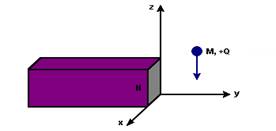
According to the axis system represented above, select the alternative that contains the correct statement.
a) The object will undergo a deviation in the positive direction of the y-axis, due to the presence of the magnetic field in the region.
b) The object will fall vertically, without any deviation until it reaches the ground, as gravitational and magnetic fields do not interact.
c) The object will undergo a deviation in the positive direction of the x-axis, due to the presence of the magnetic field in the region.
d) The object will undergo a deviation in the negative direction of the x-axis, due to the presence of the magnetic field in the region.
03-(FUVEST-SP) As occurs in TV tubes, a beam of electrons moves towards the central point O of a screen, at a constant speed. The trajectory of the electrons is modified by a vertical magnetic field B, in the direction perpendicular to the beam trajectory, whose intensity varies as a function of time t as indicated in the graph.
Due to this field, electrons hit the screen, leaving a trace represented by one of the following figures. The figure that can represent the pattern visible on the screen is: 
04-(UFMG-MG) The picture tube of a television is represented schematically in Figure I.
Electrons are accelerated from the back of this tube toward the center of the screen. Four coils—K, L, M, and N—produce variable magnetic fields that change the direction of the electrons, causing them to strike the screen at different positions, forming an image, as illustrated in Figure II. Coils K and L produce a magnetic field in the vertical direction, and coils M and N produce a magnetic field in the horizontal direction.
At a certain point, a defect in the television interrupts the electrical current in coils K and L and only coils M and N continue to work.
Select the alternative that best represents the image that this television produces in this situation.

05-(UFU-MG) A charge q moving at speed v immersed in a magnetic field B is subject to a magnetic force F mag . If v is not parallel to B, mark the alternative that presents the correct characteristics of the magnetic force F mag .
a) The work done by F mag on q is zero, since F mag is perpendicular to the plane formed by v and B .
b) The work done by F mag on q is proportional to B, since F mag is perpendicular to v.
c) The value of F mag does not depend on v, only on B; therefore F mag does not do any work on q.
d) The value of F mag is proportional to v and B, being parallel to v; therefore the work done by F mag on q is proportional to v.
06-(UNESP-SP) A mixture of radioactive substances is confined in a lead container, with a small opening through which a parallel beam of emitted particles can exit. Upon exiting, three types of particles, 1, 2 and 3, enter a region of uniform magnetic field B with velocities perpendicular to the magnetic field lines and describe trajectories as illustrated in the figure.
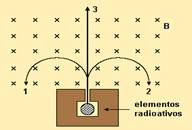
Considering the action of magnetic forces on electric charges in uniform motion, and the trajectories of each particle illustrated in the figure, it can be concluded with certainty that
a) particles 1 and 2, regardless of their masses and velocities, necessarily have charges with opposite signs and particle 3 is electrically neutral (zero charge).
b) particles 1 and 2, regardless of their masses and velocities, necessarily have charges with opposite signs and particle 3 has zero mass.
c) particles 1 and 2, regardless of their masses and velocities, necessarily have charges of the same sign and particle 3 has zero charge and mass.
d) particles 1 and 2 left the container at the same speed.
e) particles 1 and 2 have equal masses, and particle 3 has no mass.
07-(PUC-MG) A particle with charge q, speed ![]() and mass m within a magnetic field
and mass m within a magnetic field ![]() , is subject to a force
, is subject to a force ![]() due to the action of this field. Three statements were made about the situation.
due to the action of this field. Three statements were made about the situation.
I. The intensity of the force ![]() depends on the value of q.
depends on the value of q.
II. The direction of the force ![]() depends on the sign of q.
depends on the sign of q.
III. The intensity of the force ![]() depends on the velocity v and the mass m of the particle.
depends on the velocity v and the mass m of the particle.
The statement is CORRECT in:
![]()
08-(UNESP-SP ) The figure represents the trajectories of two particles, 1 and 2, left in a bubble chamber of a particle accelerator, immersed in a uniform magnetic field. It was concluded that, for these trajectories to be possible, there should be another particle, 3, which interacted with the first two. It is known that these trajectories are in the same plane, coinciding with the plane of the figure, perpendicular to the direction of the magnetic field.
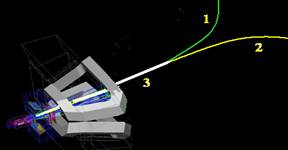
a) Knowing that the electric charge of particle 1 is positive, what is the charge of the other two particles? Justify.
b) What is the direction of the magnetic field? Justify.
09-(UFMG-MG) An electron beam initially passes between the poles of a magnet and then between two parallel plates, charged with charges of opposite signs, arranged as shown in the following figure. In the absence of the magnet and the plates, the electron beam reaches point O on the screen.
Due to the choices of the magnetic and electric fields, it can be concluded that the beam
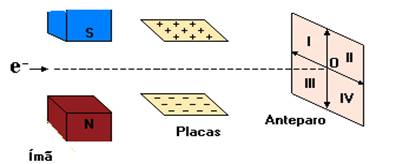
a) will reach region I of the bulkhead.
b) will reach region II of the bulkhead.
c) will reach region III of the bulkhead.
d) will reach region IV of the bulkhead.
e) will continue to reach point O of the bulkhead.
10-(UNESP-SP) It is known that at point P in the figure there is a magnetic field in the direction of line RS and pointing from R to S. When a proton (positively charged particle) passes through this point at the speed ![]() shown in the figure, a force acts on it, due to this magnetic field,
shown in the figure, a force acts on it, due to this magnetic field,
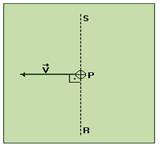
a) perpendicular to the plane of the figure and “penetrating” it.
b) in the same direction and sense of the magnetic field.
c) in the direction of the magnetic field, but in the opposite direction to it.
d) in the same direction and sense of speed.
e) in the direction of speed, but in the opposite direction to it.
11-(ITA-SP) Which of the diagrams below illustrates the movement of a charged particle in a uniform magnetic field?
Conventions:![]()
![]()

12-(UFU-MG) The figure shows the screen of an oscilloscope where a beam of electrons, which comes perpendicularly from the page to your eyes, hits the center of the screen. By bringing two identical magnets with their respective poles shown sideways to the screen, you will see that the beam:

a) will be deflected upwards
b) will be deflected downwards
c) will be shifted to the left
d) will be shifted to the right
e) will not be diverted
13-(UFSM-RS) The images, captured by an ultrasound device, are displayed on a monitor screen. The image point
on the screen is obtained by the deflection of electrons by coils, in which variable electric currents circulate, as shown in the figure.
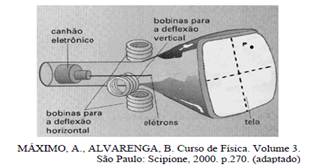
Point P, on the right of the screen, only occurs in the situation where the magnetic fields, generated by the coils, are oriented according to the figure in the alternative.

14-(UFRS) Inside a particle accelerator there is a much stronger magnetic field
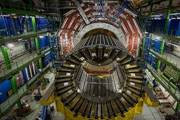
intense than the Earth’s magnetic field, oriented in such a way that an electron launched horizontally from south to north through the accelerator is deflected to the west. The accelerator’s magnetic field points:
a) from north to south
b) from east to west
c) from west to east
d) from top to bottom
e) from bottom to top
15-(UFSCAR-SP) A small sphere electrically charged with a positive charge and in free fall enters a region where a horizontal magnetic field acts uniformly.
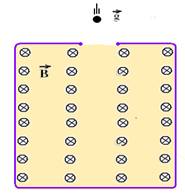
The sketch that best represents the trajectory of the sphere within this region is

16-(UNESP-SP) A particle with a positive electric charge moves in the Z – X plane in the d – b direction, which is diagonal to the square a, b, c, d indicated in figure (1). It is possible to apply a uniform magnetic field in the direction of the axes (one at a time) to the region of the charge movement, as shown in figures (2), (3) and (4).
 In which cases will the force on the particle be in the negative direction of the Y axis?
In which cases will the force on the particle be in the negative direction of the Y axis?
a) Only in case 2.
b) In cases 2 and 4.
c) Only in case 3.
d) In cases 3 and 4.
e) Only in case 4.
17-(FGV-SP) In 2008, the largest particle accelerator ever built was put into operation. In its first test, a beam of protons was kept in circular motion inside the large ring, being gradually accelerated to the desired speed.
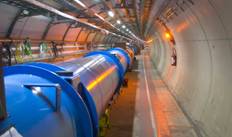
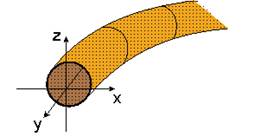
The figure shows a cross-section of this ring. Assume that a beam of protons is being accelerated along the y-axis. According to the laws of electromagnetism, the electric and magnetic fields, in that order, at the origin of the indicated system of axes have directions that point toward:
a) positive of y and negative of z.
b) positive of y and positive of z.
c) positive of y and positive of x.
d) negative of y and positive of z.
e) negative of y and negative of x.
18-(FATEC-SP) The polar faces of a magnet are placed against the video of a television set, as shown in the diagram below (north face on top, south face on bottom). The image is distorted with deviation:

a) to the left
b) to the right
c) up
d) down
e) the image is not distorted
19-(PUC-RS) An electron beam strikes horizontally at the center of the screen. By establishing a vertical magnetic field upwards, the electron beam begins to strike the screen in which region?
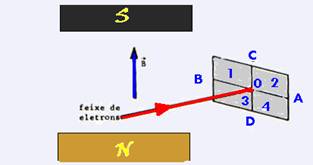
a) region 1
b) region 2
c) segment 0A
d) CD segment
e) region 3
20-(UFRRJ-RJ) A particle with charge q enters with velocity V o in a region where there is a uniform magnetic field B.

In the case where V o and B have the same direction, we can state that the particle
a) will suffer a deviation to the right.
b) will suffer a deviation to the left.
c) will be accelerated in the direction of the uniform magnetic field B.
d) will not feel the action of the uniform magnetic field B.
e) will be decelerated in the direction of the uniform magnetic field B.
21-(PUC–SP) The figure shows a representation of a magnet. The letters N and S identify the poles of the magnet, respectively, North and South. A positive charge passes at a speed ![]() through the region between the poles of this magnet and does not suffer any deviation in its direction. Under these conditions, it is correct to state that the direction and sense of
through the region between the poles of this magnet and does not suffer any deviation in its direction. Under these conditions, it is correct to state that the direction and sense of ![]() , whose module is different from zero, can be, respectively:
, whose module is different from zero, can be, respectively:
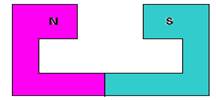
a) perpendicular to the plane of this sheet, entering it.
b) perpendicular to the plane of this sheet, coming out of it.
c) parallel to the plane of this sheet, from left to right.
d) parallel to the plane of this sheet, from top to bottom.
e) parallel to the plane of this sheet, from bottom to top.
22-(UFMG-MG) In some molecules, there is an asymmetry in the distribution of positive and negative charges, as represented schematically in the following figure.
Consider that a molecule of this type is placed in a region where there are an electric field ![]() and a magnetic field
and a magnetic field
![]() , uniform, constant and mutually perpendicular.
, uniform, constant and mutually perpendicular.
The following alternatives indicate the directions and meanings of these fields.
Select the alternative that CORRECTLY represents the equilibrium orientation of this molecule in the presence of both fields.

23-(UESC-SC) An electron beam penetrates the region of a uniform magnetic field with a module equal to B. The angle formed between the direction of the beam velocity and the field induction lines measures 60°.
Under these conditions, the trajectory described by the beam is
![]()
24-(UFJF-MG) A velocity filter is a device that uses a uniform electric field ![]() perpendicular to a uniform magnetic field
perpendicular to a uniform magnetic field ![]() (crossed fields) to select charged particles with certain velocities. The figure below shows a region of vacuum space between the flat, parallel plates of a capacitor. Perpendicular to the field produced by the plates is the uniform magnetic field. A positive particle with charge q moves in the z direction at a constant velocity
(crossed fields) to select charged particles with certain velocities. The figure below shows a region of vacuum space between the flat, parallel plates of a capacitor. Perpendicular to the field produced by the plates is the uniform magnetic field. A positive particle with charge q moves in the z direction at a constant velocity ![]() (as shown in Figure 1).
(as shown in Figure 1).

a) in figure 2, represent the electric force vectors, ![]() , and magnetic force,
, and magnetic force, ![]() , that act on the particle as soon as it enters the region of crossed fields, indicating their magnitudes.
, that act on the particle as soon as it enters the region of crossed fields, indicating their magnitudes.
b) Determine the speed that the particle must have in order not to be deflected.
25-(UFRRJ-RJ) A positively charged particle that initially has a velocity V o in the positive direction of the Y axis penetrates a region where there is a constant electric field E o , in the positive direction of the X axis, and a magnetic field B o , also constant.
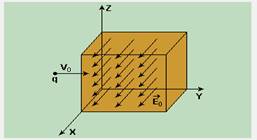
Knowing that the particle’s speed does not change, even after it begins to suffer the action of the fields, determine in terms of V o and E o :
(Disregard any gravitational effect)
a) the X component of the magnetic field;
b) the Z component of the magnetic field;
26-(PUC-SP) An electron in a cathode ray tube is moving parallel to the axis of the tube at a speed of 107 m /s.

Applying a magnetic induction field of 2T, parallel to the axis of the tube, what is the value of the magnetic force acting on the electron? Consider the charge of an electron q = 1.6.10 -19 C.
27-(UFRS-RS) The following figure represents a region of space inside a laboratory, where there is a static and uniform magnetic field. The field lines point perpendicularly into the sheet, as indicated.
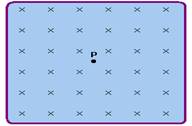
A negatively charged particle is launched from point P with initial velocity v o relative to the laboratory.
Mark with T (true) or F (false) the statements below, referring to the subsequent movement of the particle, with respect to the laboratory.
I. If v o is perpendicular to the plane of the page, the particle will follow a straight line, maintaining its initial velocity.
II. If v points to the right, the particle will deflect towards the bottom of the page.
III. If you point to the top of the page, the particle will deflect to the right.
The correct sequence, from top to bottom, is
![]()
28-(UNIFESP-SP) An electrically charged particle, initially in uniform rectilinear motion, enters a region of uniform magnetic field , perpendicular to the particle’s trajectory. The plane of the figure illustrates the particle’s trajectory, as well as the region of uniform magnetic field, delimited by the shaded area. ![]()
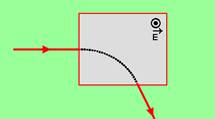
If no other field is present, it can be correctly stated that, during the passage of the particle through the region of uniform field, its acceleration is
a) tangent to the trajectory, work is done and its kinetic energy increases.
b) tangent to the trajectory, work is done and its kinetic energy decreases.
c) normal to the trajectory, no work is performed and its kinetic energy remains constant.
d) normal to the trajectory, work is done and its kinetic energy increases.
e) normal to the trajectory, no work is performed and its kinetic energy decreases.
29-(UFSCAR-SP) The Physics teacher decided to dictate a problem “for homework”, with only one minute left in the class. Copying it in a hurry, one of his students got the following incomplete note:
An electron ejected from a particle accelerator enters a chamber at a speed of 8.10 5 m/s, where a uniform magnetic field of intensity 2.0.10 -3 —– acts.
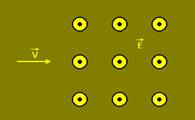
Determine the intensity of the magnetic force acting on the ejected electron, the charge of an electron being -1.6.10 -19 C .
Knowing that all units referred to in the text were in the International System,
a) What units accompany the values 2.0.10 -3 and -1.6.10 -19 , in that order?
b) solve the “homework” for the student, considering that the directions of speed and magnetic field are perpendicular to each other.
30- (UFG-GO) A particle with an electric charge of mass m is ejected into a region where there is an electric and magnetic field, both non-zero, but whose resulting force on the particle is zero. Neglecting the gravitational field, what can you say about the direction of the electric and magnetic fields? Explain your answer.
31-(UECE-CE) The greatest force of magnetic origin (measured in newtons) that can act on an electron (charge e = 1.6.10 -19 C)
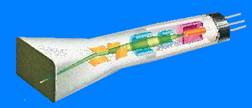
in a TV tube, where there is a magnetic field of magnitude B = 83.0 mT, when its speed is 7.0.10 6 m/s, it is approximately
![]()
32-(ITA-SP) The figure shows a particle of mass m and charge q > 0, in a region with a constant and uniform magnetic field, positively oriented on the x axis. The particle is then launched with initial velocity in the xy plane, forming the ![]()
![]()

angle θ indicated, and passes through point P, on the x-axis, at a distance d from the launch point.
Select the correct alternative.
a) The product dq B must be a multiple of 2πmvcosθ .
b) The kinetic energy of the particle is increased when it reaches point P.
c) For θ=0, the particle moves with uniformly accelerated motion.
d) The particle passes through the x-axis every time interval equal to m/qB.
e) The magnetic field does not produce acceleration in the particle.
33-(CFT-CE) A particle, with mass me and positively charged, is launched with velocity v from point P, the center of the face of a parallelepiped formed by 4 cubes with equal edges, in a region where there is a uniform magnetic field B, oriented as shown in the following figure.
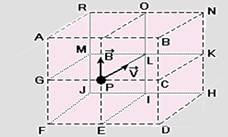
Disregarding gravitational actions, we can CORRECTLY state that the particle will follow a trajectory:
a) straight line, passing through point L
b) circular, in the vertical plane LIEP
c) circular, in the horizontal plane LKCP
d) parabolic, in the vertical plane GFEP
e) straight line, passing through point K
34- (UEPB) One way to obtain information about the charge and mass of a particle is to make it pass through a uniform magnetic field. From its circular trajectory, one can, knowing the field, the particle’s speed and the radius of the trajectory, determine the sign of the electric charge and the value of the mass. The figure shows part of trajectories 1 and 2 left by two particles P 1 and P 2 , respectively. The dots indicate a constant magnetic field B that leaves perpendicular to the test paper. Consider that the two particles, P 1 and P 2 , have charges of the same magnitude and opposite signs and penetrate perpendicularly, with the same constant speed V o , into the region of field B. Analyzing the trajectories and taking as a basis the magnetic field shown, it is concluded that:

a) Particle P 1 has a negative charge and the value ![]() is greater than that of particle P 2 .
is greater than that of particle P 2 .
b) Particle P 1 has a positive charge and the value ![]() is greater than that of particle P 2 .
is greater than that of particle P 2 .
c) Particle P 1 has a positive charge and the value ![]() is less than that of particle P 2 .
is less than that of particle P 2 .
d) Particle P 1 has a negative charge and the value ![]() is less than that of particle P 2 .
is less than that of particle P 2 .
e) Particle P 1 has a positive charge and the value ![]() is the same as that of particle P 2 .
is the same as that of particle P 2 .
35-(UFSC ) The figure represents a mass spectrometer, a device used to determine the mass of ions. In source F, ions are produced, practically at rest. The ions are accelerated by a potential difference VAB , acquiring a speed ![]() and being launched into a region where there is a uniform magnetic field
and being launched into a region where there is a uniform magnetic field ![]() . Each ion describes a semicircular trajectory, reaching a photographic plate at a point that is recorded, and the radius R of the trajectory can be determined.
. Each ion describes a semicircular trajectory, reaching a photographic plate at a point that is recorded, and the radius R of the trajectory can be determined.

Considering the situation described, select the CORRECT proposition(s):
(01) The charge of the ions, whose trajectories are represented in the figure, is positive.
(02) The kinetic energy E C that the ion acquires, when accelerated by the electric potential difference V AB , is equal to the work done on it and can be expressed by E C = qV AB , where q is the charge of the ion.
(04) The charge of the ions, whose trajectories are represented in the figure, can be either positive or negative.
(08) The radius of the trajectory depends on the mass of the ion, and this is exactly why it is possible to distinguish ions with the same electric charge and different masses.
(16) Even if the ion does not have an electric charge, it will be affected by the magnetic field, which will act with a force perpendicular to its speed ![]() .
.
36-(UNICAMP-SP) The use of crossed electric and magnetic fields is important to enable the use of the hybrid technique of magnetic resonance tomography and X-rays. The figure below shows part of an X-ray tube, where an electron, moving at a speed v = 5.0.105 m /s along the x direction, penetrates the region between the plates where there is a uniform magnetic field, , directed perpendicularly into the plane of the paper. The mass of the electron is m e = 9.10 -31 kg and its electric charge is q = -1.6.10 -19 C. The magnitude of the magnetic force acting on the electron is given by F = qvB senθ, where θ is the angle between the speed and the magnetic field. ![]()
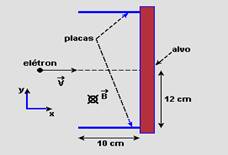
a) If the magnitude of the magnetic field B = 0.010T, what is the magnitude of the electric field that must be applied in the region between the plates so that the electron remains in uniform rectilinear motion?
b) In another situation, in the absence of an electric field, what is the maximum value of B so that the electron still reaches the target? The length of the plates is 10 cm.
37-(FUVEST-SP) A proton with mass M = 1.26.10 -7 kg, with electric charge Q = 1.6.10 -19 C, is launched at A, with velocity v o , in a region where a uniform magnetic field B acts, in the x direction. The velocity v o , which forms an angle θ with the x axis, has components v o x = 4.0.10 6 m/s and v o y = 3.0.10 6 m/s. The proton describes a helix-shaped movement, returning to cross the x axis, at P, with the same initial velocity, at a distance L o = 12 m from point A.
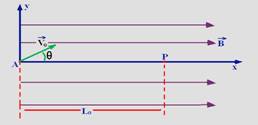
Disregarding the action of the gravitational field and using π=3, determine:
a) the time interval Δt, in seconds, that the proton takes to go from A to P.
b) the radius R, in meters, of the cylinder that contains the helical trajectory of the proton.
c) the intensity of the magnetic field B, in tesla, that causes this movement.
38-(UFBA) The figure shows the experiment carried out by JJ. Thomson to determine the charge/mass ratio of the electron. In this experiment, the electrons, with mass m and charge q, are emitted by the source F, from rest, and accelerated by the ddp U of the source, penetrating the region of the uniform magnetic induction field , through the hole O in the plate and incident on point P. ![]()
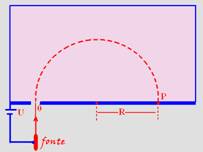
Disregarding gravitational actions, it is correct to state:
01. The lines of magnetic induction are perpendicular to the plane of the figure, oriented outwards from that plane.
02. The magnetic force acting on electrons runs from left to right.
04. In the region of ![]() , the variation in kinetic energy is zero.
, the variation in kinetic energy is zero.
08. The measurement of the segment OP is mv/qB
16. The time that electrons remain in the region ![]() is πm/qB
is πm/qB
Give as your answer the sum of the numbers corresponding to the correct statements.
39-(IME–RJ) Consider an electron with mass m and charge -e, which moves at a speed as indicated in the figure. At instant t = 0, a uniform magnetic field is turned on throughout space. Disregarding the action of gravity, determine: ![]()
![]()
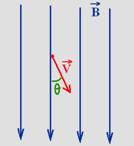
a) the work done by the magnetic force after a time interval Δt.
b) the period of motion in the plane perpendicular to ![]() .
.
c) the trajectory followed by the electron, graphically.
40-(UFRJ-RJ) A particle with mass m and positive electric charge q enters a region in which there are an electric field and a magnetic field, both uniform, constant, perpendicular to each other and with respective modules E and B. The weight of the particle is totally negligible compared to the electric force, so we can assume only the electric and magnetic forces acting on the particle in the region.
The particle enters the region with initial velocity ![]() , of magnitude v o = 2E/B and direction perpendicular to the electric and magnetic fields, and deviates until it reaches, with zero velocity, a maximum distance d from the line supporting the initial velocity
, of magnitude v o = 2E/B and direction perpendicular to the electric and magnetic fields, and deviates until it reaches, with zero velocity, a maximum distance d from the line supporting the initial velocity ![]() . The particle returns to approach this line, so that its trajectory is a flat curve as illustrated in the following figure.
. The particle returns to approach this line, so that its trajectory is a flat curve as illustrated in the following figure.
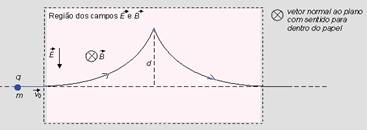
Considering E, B, qem as data, calculate the distance d.
41-(UNESP-SP) A technology capable of providing high energies to elementary particles can be found in particle accelerators, such as cyclotrons. The basic principle of this technology consists of the movement of electrically charged particles subjected to a magnetic field perpendicular to their trajectory.
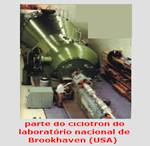
A cyclotron was built to use a uniform magnetic field, ![]() , with a constant magnitude of 1.6 T, capable of generating a magnetic force,
, with a constant magnitude of 1.6 T, capable of generating a magnetic force, ![]() , always perpendicular to the particle’s velocity. Consider that this magnetic field, when acting on a positive particle with a mass of 1.7 x 10 –27 kg and a charge of 1.6 x 10 –19 C, causes the particle to move along a path that, at each turn, can be considered circular and uniform, with a velocity of 3.0 x 10 4 m/s. Under these conditions, the radius of this circular path would be approximately
, always perpendicular to the particle’s velocity. Consider that this magnetic field, when acting on a positive particle with a mass of 1.7 x 10 –27 kg and a charge of 1.6 x 10 –19 C, causes the particle to move along a path that, at each turn, can be considered circular and uniform, with a velocity of 3.0 x 10 4 m/s. Under these conditions, the radius of this circular path would be approximately
- 1 x 10 –4 m.
- b) 2 x 10 –4 m.
- c) 3 x 10 –4 m.
- d) 4 x 10 –4 m.
- e) 5 x 10 –4 m.
42-(UFMG-MG) Nuclear reactions that occur in the Sun produce particles – some electrically charged –, which are launched into space. Many of these particles come towards Earth and can interact with the planet’s magnetic field.
In this figure, the lines indicate, approximately, the direction of the magnetic field around the Earth:
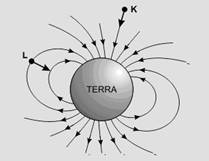
In this figure, K and L represent two electrically charged particles and the arrows indicate their velocities at a certain instant.
Based on this information, Alice and Clara come to these conclusions:
• Alice – “Regardless of the sign of its charge, the L particle will have the direction of its velocity altered by the Earth’s magnetic field.”
• Clara – “If the K particle has a negative electric charge, its speed will be reduced by the Earth’s magnetic field and it may not reach it.”
Considering the situation described, it is CORRECT to state that
a) only Alice’s conclusion is correct.
b) only Clara’s conclusion is correct.
c) both conclusions are correct.
d) neither of the two conclusions is correct.
43-(ITA-SP) An electron is accelerated from rest through a potential difference V and enters a region in which a magnetic field acts, where it begins a cyclotronic motion, moving in a circle of radius RE with period TE. If a proton were accelerated from rest through a potential difference of the same magnitude and entered the same region in which the magnetic field acts, we could state about its radius RP and period TP that
a) RP = RE and TP = TE.
b) RP > RE and TP > TE.
c) RP > RE and TP = TE.
d) RP < RE and TP = TE.
e) RP = RE and TP < TE.
44-(UFMS-MS) The LHC accelerator collided two protons, rotating in circular trajectories with opposite directions, one clockwise and the other counterclockwise, see the figure. Consider that the trajectories of the protons before the collision were kept circular due solely to the interaction of magnetic fields perpendicular to the plane of the protons’ orbits. Based on electromagnetism, it is correct to state:
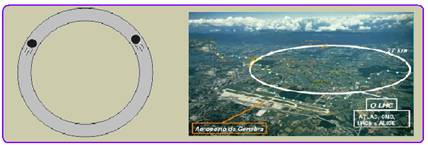
01) The purpose of the magnetic field is only to change the direction of the speed of the protons.
02) The purpose of the magnetic field is to increase the kinetic energy of protons.
04) The proton that is rotating counterclockwise is subjected to a magnetic field that has a direction that is entering the plane of the page.
08) The magnetic force applied to each proton has a direction tangent to the trajectory.
16) The magnetic force applied to each proton does no work.
45-(UNIRG-TO)

![]()

This configuration of electric and magnetic fields acts as a speed selector for charged particles. Neglecting the gravitational force, the speed at which the particle does not undergo deflection, i.e., the electric force cancels out the magnetic force, is given by
![]()
46-(UFG-GO)
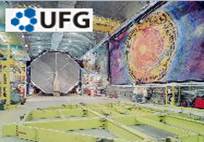
A cavity in a block of lead contains a radioactive sample of the chemical element barium. Figure (a) illustrates the trajectories of the a, b, and g particles emitted after radioactive decay.
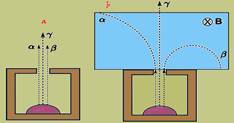
A uniform magnetic field is applied entering the plane of the sheet, as illustrated in figure (b). The behavior represented by the trajectories occurs because
a) particle b has a positive charge and greater momentum than particle a.
b) particles a and b have opposite charges and the same momentum.
c) particle a has a positive charge and greater momentum than b.
d) particle a has a greater charge and less momentum than particle b.
e) particle g has a positive charge and less momentum than b.
47-(FUVEST-SP)

The following figure shows the schematic of an instrument (mass spectrometer), consisting of two parts. In the first part, there is an electric field ![]() , parallel to this sheet of paper, pointing downwards, and also a magnetic field
, parallel to this sheet of paper, pointing downwards, and also a magnetic field ![]() , perpendicular to this sheet, entering it. In the second, there is a magnetic field,
, perpendicular to this sheet, entering it. In the second, there is a magnetic field, ![]() of the same direction as
of the same direction as ![]() , but in the opposite direction. Positive ions, coming from a source, penetrate the first part and, due to the pair of slits F 1 and F 2 , only particles with velocity
, but in the opposite direction. Positive ions, coming from a source, penetrate the first part and, due to the pair of slits F 1 and F 2 , only particles with velocity ![]() , in the direction perpendicular to the vectors
, in the direction perpendicular to the vectors ![]() and
and ![]() , reach the second part of the equipment, where the ions of mass m and charge q have a circular trajectory with radius R.
, reach the second part of the equipment, where the ions of mass m and charge q have a circular trajectory with radius R.

a) Obtain the expression for the speed module ![]() as a function of
as a function of ![]() and
and ![]() .
.
b) Determine the m/q ratio of the ions as a function of the parameters E, B 1 , B 2 and R.
c) Determine, as a function of R, the radius R’ of the circular trajectory of the ions, when the magnetic field, in the second part of the equipment, doubles in intensity, with all other conditions maintained.

48-(UFOP-MG)

The cyclotron is an accelerator in which charged particles perform circular motion in a

plane perpendicular to a uniform magnetic field of magnitude B. If the magnetic field is the only applied field, the angular velocity of the resulting circular motion depends only on the charge/mass ratio and on B. In a typical accelerator, the value of B is 1 tesla and the particles travel along a path with a radius of 50 cm.
What is the order of magnitude of the particle’s speed (data: charge equal to 1.6.10 -19 C and mass equal to 1.67.10 -27 kg)?
![]()
49-(UEPG-PR)

Electric charges in motion create a magnetic field. When an electric charge is in motion in a magnetic field, there is an interaction between this field and the field created by the charge. This interaction is manifested by a force acting on the electric charge, which is called magnetic force.
Regarding magnetic force, mark what is correct.
01) The direction of the magnetic force depends on the sign of the moving charge.
02) The direction of the magnetic force on a moving charge is perpendicular to the plane formed by the charge velocity vector and the magnetic induction vector.
04) When an electric charge is launched perpendicularly towards a uniform magnetic field, the charge will describe a circular trajectory.
08) The magnetic force on an electric charge moving in a direction parallel to the direction of the uniform magnetic field is zero.
50-(UFTM-MG)

An electron enters a region between two flat, parallel plates through slit F 1 and passes through it in the dashed direction shown in the figure, exiting through slit F 2 , without being deflected.

During the crossing, the electron is subject to a magnetic induction field ![]() and an electric field
and an electric field ![]() , both uniform. Considering the xyz reference system, and knowing that the plates are parallel to the xz plane, this will be possible if
, both uniform. Considering the xyz reference system, and knowing that the plates are parallel to the xz plane, this will be possible if
a) ![]() has the same direction and the same sense as the x-axis, and
has the same direction and the same sense as the x-axis, and ![]() has the same direction and the same sense as the z-axis.
has the same direction and the same sense as the z-axis.
b) ![]() has the same direction and the same sense as the z-axis, and
has the same direction and the same sense as the z-axis, and ![]() has the same direction and the same sense as the y-axis.
has the same direction and the same sense as the y-axis.
c) ![]() has the same direction and the same sense as the y-axis, and
has the same direction and the same sense as the y-axis, and ![]() has the same direction and the opposite sense to the z-axis.
has the same direction and the opposite sense to the z-axis.
d) ![]() and
and ![]() have the same direction and the same sense of the z axis.
have the same direction and the same sense of the z axis.
e) ![]() and
and ![]() have the same direction and the same sense of the x-axis.
have the same direction and the same sense of the x-axis.
51-(ITA-SP)

Protons (charge e and mass m p ), deuterons (charge e and mass m d = 2m p ) and alpha particles (charge 2e and mass m a = 4m p ) enter a uniform magnetic field ![]() perpendicular to their velocities, where they move in circular orbits of periods T p , T d and T a , respectively. It can be stated that the ratios of the periods T d /T p and T a /T p are, respectively,
perpendicular to their velocities, where they move in circular orbits of periods T p , T d and T a , respectively. It can be stated that the ratios of the periods T d /T p and T a /T p are, respectively,
![]()
52-(UNIMONTES-MG)

A charged particle is injected into a region where only a magnetic field of magnitude B acts, perpendicular to the initial motion of the particle (see the figure below). This field is
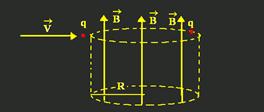
sufficient to cause the particle to describe a circular motion. The charge of the particle is three times the charge of the electron, the magnitude of the field is 2 T, and the magnitude of the particle’s velocity is V = 10 -4 .c, where c is the speed of light in a vacuum. If the mass of the particle is M = 3.10 -25 kg, the radius R described by the particle will be approximately
Data: e = 1.6.10 -19 C ec=3.10 8 m/s
![]()
53-(UFRJ-RJ)

A particle of mass m and positive charge q, in uniform rectilinear motion, enters a region in which there is a uniform, vertical magnetic field of magnitude B. Upon leaving the region, it resumes uniform rectilinear motion.
All movement occurs in a horizontal plane and the direction of the final rectilinear movement makes an angle θ with the direction of the initial rectilinear movement. The speed of the particle is large enough for us to neglect the gravitational force, so that we can consider only the magnetic force on it.
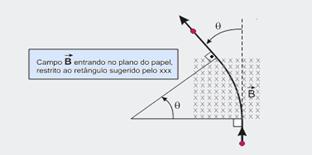
a) Determine the ratio v’ / v between the module v’ of the velocity of the final rectilinear motion and the module v of the velocity of the
initial rectilinear movement.
b) Calculate how long it takes for the particle to cross the region where there is a magnetic field as a function of q, m, B and ![]() .
.
54-(UFPR-PR)

An interesting experiment that allows us to determine the speed ![]() at which elementary particles move consists of using a magnetic field
at which elementary particles move consists of using a magnetic field ![]() in combination with an electric field
in combination with an electric field ![]() . An elementary particle with a negative charge Q moves at a speed
. An elementary particle with a negative charge Q moves at a speed ![]() parallel to the plane of the paper (inertial reference frame) and enters a region where there is a
parallel to the plane of the paper (inertial reference frame) and enters a region where there is a ![]() uniform, constant magnetic field oriented inwards from the plane of the paper, as shown in the figure. When moving in the region of the magnetic field, the particle is subject to a magnetic force
uniform, constant magnetic field oriented inwards from the plane of the paper, as shown in the figure. When moving in the region of the magnetic field, the particle is subject to a magnetic force ![]() .
.
a) Obtain a literal expression for the module of ![]() and represent in the figure the vector
and represent in the figure the vector ![]() for the indicated position of the particle.
for the indicated position of the particle.
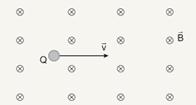
b) A system is available that can generate a ![]() uniform, constant electric field parallel to the plane of the paper, which produces an electric force
uniform, constant electric field parallel to the plane of the paper, which produces an electric force ![]() on the particle. Represent in the figure the vector
on the particle. Represent in the figure the vector ![]() necessary for the particle with charge Q to move in uniform rectilinear motion. Then, obtain a literal expression for the module of the
necessary for the particle with charge Q to move in uniform rectilinear motion. Then, obtain a literal expression for the module of the ![]() particle’s velocity when it performs this movement, as a function of the quantities presented in the statement.
particle’s velocity when it performs this movement, as a function of the quantities presented in the statement.
55-(UCPEL-RS)

Consider the statements below and analyze them as TRUE (T) or FALSE (F).
I. An electric charge placed in a magnetic field is always subject to a force.
II. At each point, the magnetic field lines are perpendicular to the magnetic field vector.
III. An electron moves in a vacuum at a constant speed, when it penetrates a uniform magnetic field with a direction perpendicular to its speed, it begins to move in a uniformly accelerated rectilinear motion.
IV. If several resistors are connected in parallel, the one with the greatest resistance dissipates greater electrical power due to the Joule effect.
V. The resistivity of a conductor is directly proportional to its length.
The correct sequence is
(A) T – T – F – F – F
(B) V – V – V – V – V
(C) T – T – F – T – T
(D) F – T – F – F – T
(E) F – F – F – F – F
56-(PUC-RJ)
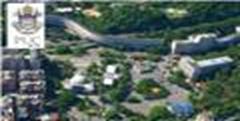
In a physics experiment, it is observed that a point electric charge with electric charge q = 2 x 10 -3 C moves at a constant speed v = 4 m/s, parallel to the y-axis, as illustrated by the dashed trajectory in the figure.
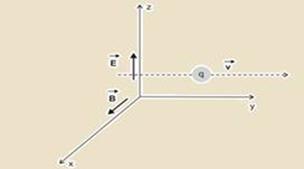
Knowing that the region of space through which the charge moves has an electric field E = 2 N/C along the z axis and a magnetic field B along the x axis, both uniform, also represented in the figure, determine:
a) module, direction and sense of the force exerted by the electric field on the charge q;
b) magnitude of the magnetic field in Ns/mC) acting on the charge
57-(UEM-PR)

A particle, of mass M and positive electric charge Q, is thrown horizontally with velocity ![]() , from right to left, in a region of space where there is a vacuum and a uniform electric field
, from right to left, in a region of space where there is a vacuum and a uniform electric field ![]() , which is directed from above
, which is directed from above
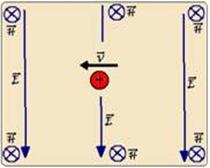
downwards. In this region of space, there is also a uniform magnetic field ![]() , oriented perpendicularly to the plane of the page. With this information, disregarding the action of gravity, mark the correct one.
, oriented perpendicularly to the plane of the page. With this information, disregarding the action of gravity, mark the correct one.
01) The magnitude of the resulting force acting on the particle is Q(vH + E).
02) For the particle’s trajectory to remain straight, the module of its launch velocity must be V o = E/H.
04) In the situation described in the statement, the particle’s trajectory is always deflected downwards.
08) The lines of force of the magnetic field form closed surfaces.
16) The passage of the charged particle in the region of the electric and magnetic fields alters the physical characteristics of these fields.
58-(UFES-ES)

A rigid, insulating block of mass 400 g has a positive built-in electric charge of 10.0 C and is at rest on a surface defined by the zy plane at point A, as shown in the figure to the side.
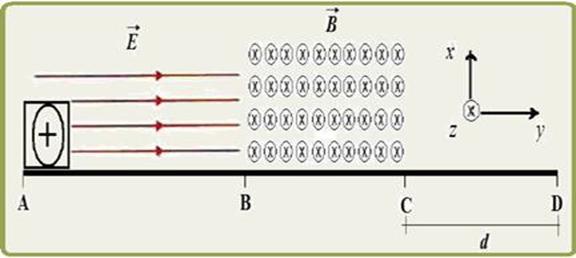
A uniform and constant electric field of intensity 1.00.10 2 N/C is kept on, accelerating the block linearly until it reaches point B. In the section between points B and C, a uniform and constant magnetic field is applied perpendicular to the xy plane represented by this sheet of paper and in the direction inside the paper. Assume that the block can slide freely, without friction, between points A and C; however, there is friction between points C and D.
A) Determine the speed of the block at the moment immediately before reaching point B. Consider that the block is a material point and that the distance between A and B is 50.0 cm.
B) Identify and draw, on a diagram, the forces acting on the block when it is located between points B and C.
C) Find the intensity of the magnetic field so that the contact force between the block and the surface defined by the zy plane is zero in the section from B to C.
D) Determine the coefficient of kinetic friction between the block and the surface defined by the plane zy as a function of v, g and d, considering that the block arrives at point C with a horizontal speed v and stops at point D, traveling a distance d.
59-(UDESC-SC)

The figure represents a region of space where there is a uniform magnetic field ![]() oriented perpendicularly to the plane of this figure. A particle with a positive mass and charge that penetrates this region of magnetic field, perpendicular to the lines of
oriented perpendicularly to the plane of this figure. A particle with a positive mass and charge that penetrates this region of magnetic field, perpendicular to the lines of
field, with constant speed ![]() .
.

Considering the situation described above, select the incorrect alternative.
a. ( ) The period of movement executed by the particle in the magnetic field region does not depend on its speed ![]() .
.
b. ( ) The work done by the magnetic force on the particle is nonzero.
c. ( ) The frequency of movement is inversely proportional to the mass m of the particle.
d. ( ) The magnitude of the magnetic force acting on the particle is determined by the product qVB.
e. ( ) The radius of the trajectory executed by the particle in the magnetic field region is proportional to the particle’s momentum.
60-(EsPCEx)

Under the exclusive action of a uniform magnetic field of intensity 0.4 T, a proton describes a
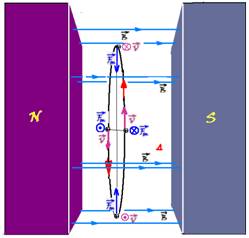
uniform circular motion of radius 10 mm in a plane perpendicular to the direction of this field. The ratio between its mass and its charge is 10 -8 kg/C. The speed at which the proton describes this motion is:
![]()
